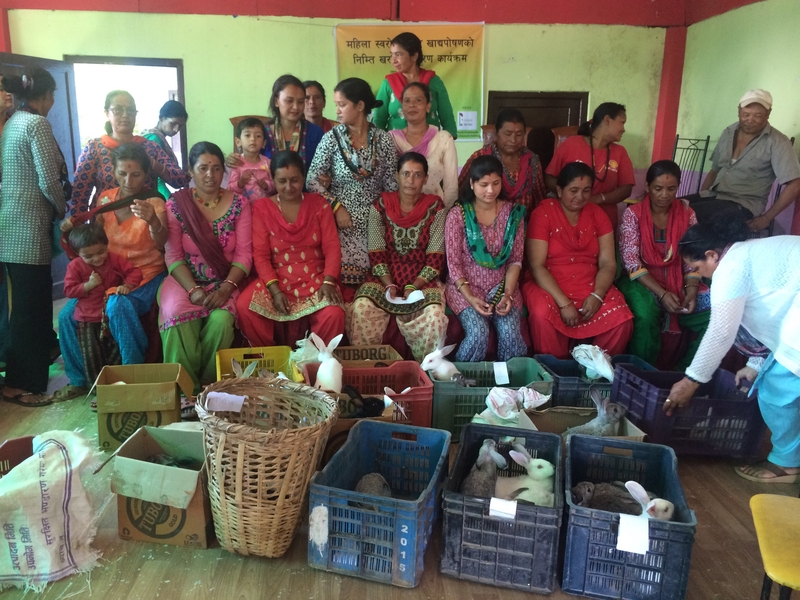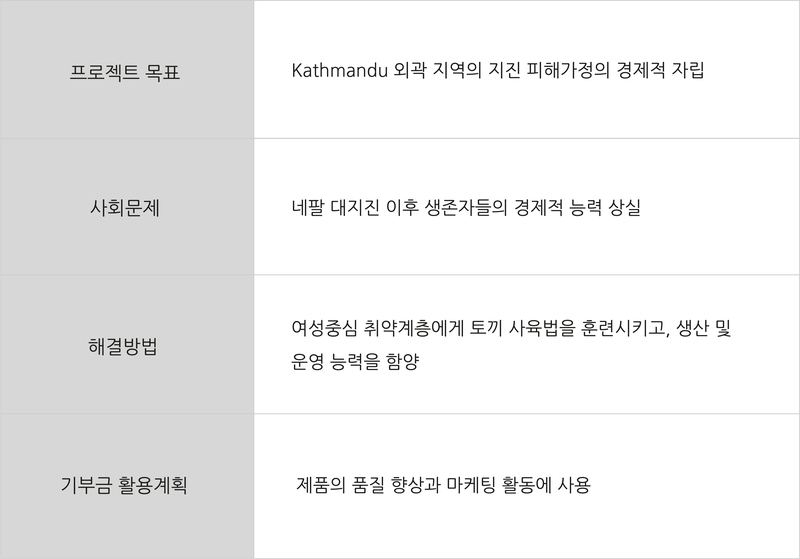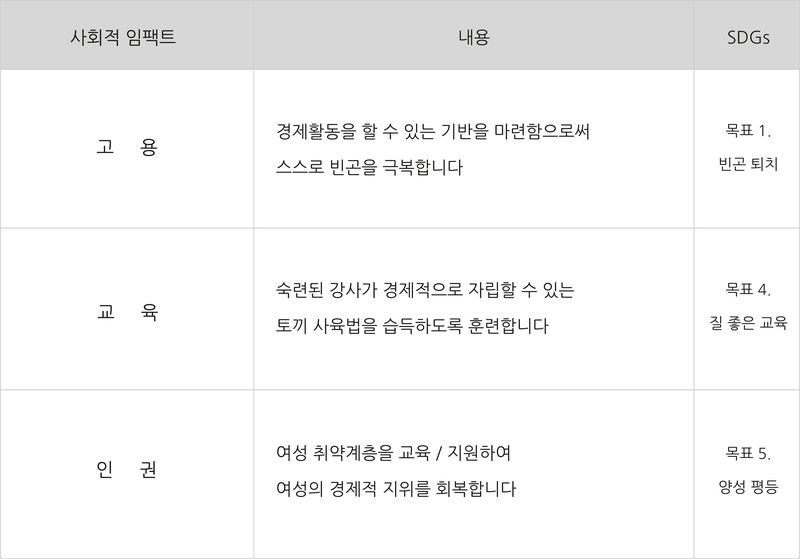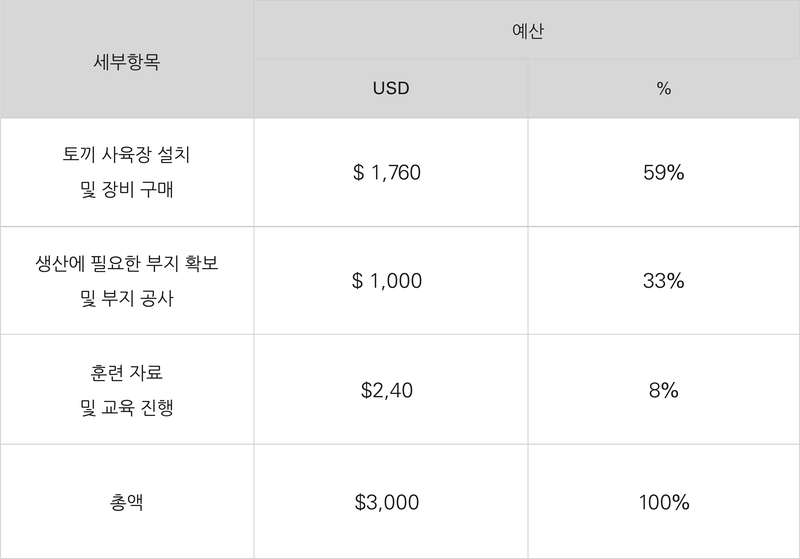토끼농장 지원으로
네팔 빈곤층의 자립에 함께 해주세요!
네팔 현지 사람들에게 토끼농장은 어떤 의미일까요?
"토끼의 빠른 번식은 네팔 지진 피해자들의 영양실조와 경제적 빈곤을
극복할 수 있는 현지에 적합한 효과적인 자립 사업입니다!"
1. 프로젝트 배경
네팔은 구매력 평가(Purchasing Power Parity)에서 세계 하위 수준인 가장 가난한 국가 중에 하나입니다. 2016년 대한민국의 구매력은 세계 49위 $35,790인 반면, 네팔은 187위 $2,520입니다*.
2015년 5월, 진도 7.8을 넘어 8천 명의 사상자를 낸 네팔 대지진을 기억하고 있나요? 대지진 후 도시의 일자리는 더욱 부족해졌습니다. 대부분의 사람들이 가지고 있던 자산을 잃어버렸고, 네팔 경제에서 가장 큰 부분을 차지하는 농업과 농산품 가공도 어려워지면서 네팔 사람들은 삶은 더욱 힘들어졌습니다.
수확 기간이 긴 농사를 짓는 것보다 토끼 사육은 번식이 빠르고 관리도 어렵지 않아, 경제적 자립과 식량부족의 문제를 해결하는 효과적 수단이 되고 있습니다. 최근 네팔 정부도 토끼 사육에 많은 관심을 보이며 관련 사업을 확장을 지원하고 있으며, 일반 시민들의 토끼고기 수요도 지속적으로 증가하고 있습니다.
히말라야 Rabbit Farm은 네팔의 취약계층의 자립과 심리적 회복을 목표로 운영하는 사회적 기업입니다. 2012년도에 설립되었고, 지진 피해자들의 효과적인 경제활동을 지원합니다. 히말라야 Rabbit Farm은 토끼 사육과 농장의 운영을 교육하고 있습니다. 특히 대지진이 발생한 2015년 이후에는 사업을 확장하여 11개 지역에서 500명 이상의 농민, 200가구가 넘는 여성 취약계층과 함께 토끼농장을 운영하고 있습니다.
* 2016년 각 국가 구매력 평가에 대한 자료는 World Bank 자료를 참고해주세요.
네팔에 대한 자세한 정보는 위키피디아를 참고해주세요.

[토끼농장 운영자들]
2. 프로젝트 개괄

사리타는 2015년 지진으로인해 집과 재산을잃고, 가까웠던 이웃 3명을 하늘로 떠나 보냈습니다. 그녀는 대지진 후 안정적인 수입원이 없는 남편과 가난한 가정을 꾸려갈 방안을 찾아보았습니다. 그 과정 중에 히말라야 Rabbit Farm을 통해 그녀는 토끼 사육을 시작할 수 있게 되었고, 이제 새로운 희망이 생겼습니다. 영양가가 높은 토끼 고기를 늘 배고파했던 5살짜리 아들에게 먹일 수 있었으며, 최근에는 한 달에 약 $50의 수익을 창출하여 아들에게 줄 우유도 구매하고 있습니다.

사리타 타망, 토끼 농장운영자 -
히말라야 토끼농장은 토끼 사육법 교육 및 운영 대상자 선정, 그리고 초반 운영설비 및 후속판매 지원까지 농장 운영자들과 함께 하고 있습니다. 또한, 히말라야 Rabbit Farm의 80% 이상 운영자들은 여성으로 구성되어 있습니다.

[히말라야 Rabbit Farm의 교육]
"히말라야 Rabbit Farm은 대지진 이후 피해를 입은 사람들의
빈곤을 해결하기 위해 사업을 확장하고 있습니다"
토끼 사육의 교육 및 농장 운영지원은 어려운 상황에 처한 네팔 11개 농촌 지역을 대상으로 운영되고 있습니다. 현재 히말라야 Rabbit Farm은 500명 이상의 농민, 200가구가 넘는 여성 취약계층과 함께 토끼사육 사업을 운영을 하고 있습니다.

[히말라야 Rabbit Farm 토끼 사육시설]

[여성 운영자들이 토끼를 판매하는 모습]

[토끼 가공을 위해 운송]
3. 사회적 임팩트
 * 본 사업은 UN SDGs(지속 가능한 개발목표)를 이루고자 합니다. SDGs에 대한 자세한 내용은 UN 홈페이지를 확인하세요.
* 본 사업은 UN SDGs(지속 가능한 개발목표)를 이루고자 합니다. SDGs에 대한 자세한 내용은 UN 홈페이지를 확인하세요.

[히말라야 Rabbit Farm의 비즈니스 모델]
4. 임팩트 기부금 사용계획
히말라야 Rabbit Farm은 대지진 피해자들과 함께하고자 합니다. 피해자들이 토끼를 사육하는 것은 단순하게 돈만 버는 것이 아닙니다. 사육 활동을 통해 책임감을 갖고, 트라우마와 빈곤을 함께 이겨낼 수 있습니다. 그리고 희망을 가지고 더 나은 미래를 꿈꾸게 됩니다. 임팩트 기부를 통해 모인 자금은 농장 운영자 양성을 위해 사용됩니다. 농장 부지확보, 사육장 설비, 훈련기기 구매, 진공포장 기계 구매에 사용할 계획입니다.

히말라야 Rabbit Farm은 네팔 여성을 중심으로
지진 피해로 인한 취약계층들에게
토끼 사육의 기회를 주고 있습니다.
그들의 자립에 함께 해주세요!